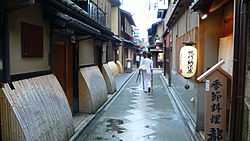Ponto-chō


Ponto-chō (先斗町) is a Hanamachi district in Kyoto, Japan, known for geisha and home to many geisha houses and traditional tea houses. Like Gion, Pontochō is famous for the preservation of forms of traditional architecture and entertainment.
Etymology
The name Ponto-chō is said to be a portmanteau of the English word "point" or more probably the Portuguese word "ponte" (bridge) or even "ponto" (also meaning point) and the Japanese word "-chō" meaning town, block or street.
District
Ponto-chō centres around one long, narrow, cobbled alley running from Shijō-dōri to Sanjō-dōri, one block west of the Kamo River (Kamo-gawa). This is also the traditional location of the start of kabuki, and a statue of Okuni still stands on the opposite side of the river. The district crest is a stylized water plover or chidori.
Cultural features
Geisha have existed in Ponto-chō since at least the 16th century, as have prostitution and other forms of entertainment. Today the area, lit by traditional lanterns at night, contains a mix of very expensive restaurants — often featuring outdoor riverside dining on wooden patios — geisha houses and tea houses, brothels, bars, and cheap eateries.
The area is also home to the Pontochō Kaburenjō Theatre at the Sanjō-dōri end of the street. This theatre functions as a practice hall for geisha and twice a year since the 1870s Kyoto geisha perform the Kamogawa Odori — Kamogawa river dancing, a combination of traditional dance, kabuki-like theatre, singing and the playing of traditional instruments — there, offering a rare chance for ordinary people to see performances by real geisha.
See also
- 5 famous Hanamachi in Kyoto ("Gokagai")
- Gion-Kohbu
- Gion-Higashi
- Kamishichiken
- Miyagawacho
- Pontocho
- Another in Kyoto
External links
| Wikimedia Commons has media related to Pontocho. |
| Wikimedia Commons has media related to Pontocho riverside. |